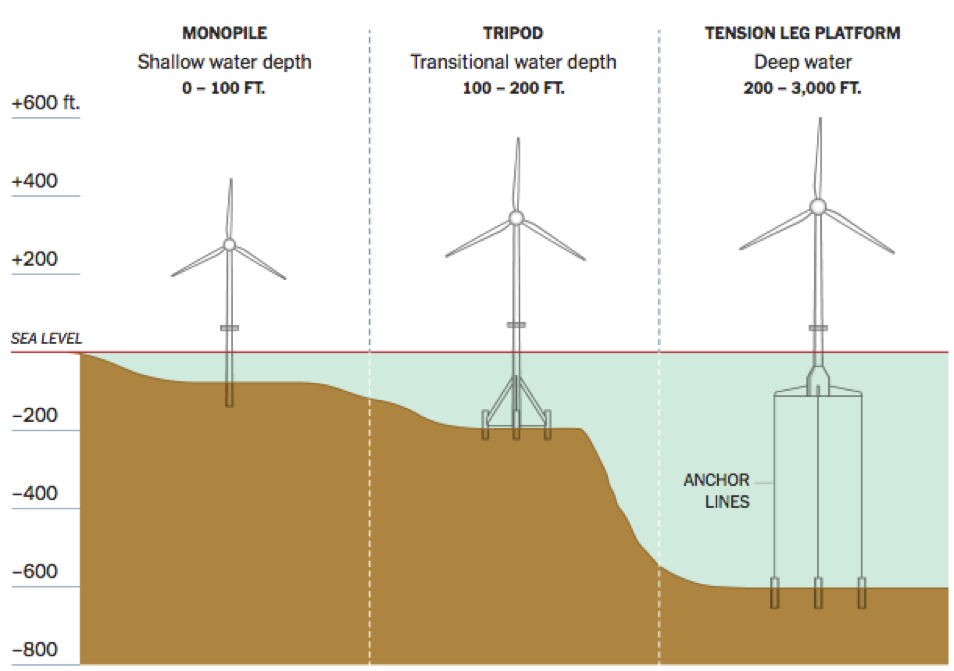Last month, the Department of the Interior’s Bureau of Ocean Energy Management (BOEM) issued a call to companies to gauge interest in leasing about 688,000 acres off the coast of Central and Northern California for offshore wind. The West Coast has lagged behind the East Coast for offshore wind lease sales because of geography. Unlike the East Coast, much of the waters off the West Coast are too deep for existing wind turbines, which are grounded to the sea floor. As a result, developers would need to build turbine farms that float. The towers, located 15 to 30 miles offshore, would be hundreds of feet tall and cables would connect the wind turbines to the electric grid on shore. These wind turbines would be in much deeper water than anything that has been built so far worldwide.
Digging Deeper
Building offshore wind farms in deep waters like those off California presents particular challenges. In shallower waters, moorings can be driven directly into the ocean floor. But for greater depths, companies are developing and deploying various designs for floating platforms—like the tension leg platform below—in which the tower is fixed, with anchor lines mooring the platform to the seabed.

The Bureau of Ocean Energy Management identified three areas for the leases: a parcel off Humboldt County in Northern California and two sites in the Morro Bay area on the Central Coast, near the Hearst Castle and Diablo Canyon. Proposals are expected from the Redwood Coast Energy Authority in Humboldt County, which is seeking developers for 10 to 15 floating wind units. Redwood Coast is a government-run utility serving 60,000 customers in a mostly rural area. It expects to spend about $500 million for the wind farm.
Other potential bidders are Trident Winds, which wants to build a 100-unit wind farm on the Central Coast through a partnership called Castle Wind; and Magellan Wind, which is working with Copenhagen Infrastructure Partners, a Danish investment firm involved in a wind project off Massachusetts.
If all regulatory hurdles are cleared, leases could be signed in 18 months and floating wind farms could begin producing power within six years.
Other Offshore Wind Projects
The only utility-scale offshore wind project to come online in the United States is a small five-turbine, 30-megawatt wind farm off of Block Island in the state of Rhode Island. That project was completed in 2016. It was an expensive project, costing $300 million–$10,000 per kilowatt–over 10 times more than the cost of a new natural gas combined cycle unit. Block Island, however, is accustomed to expensive power. Prior to the completion of the wind farm, Block Island had relied on electricity generated by diesel generators, getting the diesel from floating tankers ferried across 18 miles of water. During the summer, the Block Island Power Company charged 24 cents per kilowatt hour for its generation fees because diesel tends to be very pricey on islands due to the logistics of obtaining the fuel and siting the generators. The Block Island Offshore Wind Farm’s electricity was priced starting at 24 cents per kilowatt hour under a 20-year power purchase agreement with National Grid.
The federal government has also awarded active commercial wind leases off the Eastern Seaboard, along the coasts of Massachusetts, New York, New Jersey, Maryland, Delaware, Virginia, and North Carolina. Most of those lease sales occurred under the Obama Administration. The Trump Administration, however, has auctioned off leases for 112,000 acres off the coast of North Carolina and will hold bidding for leases for an additional 390,000 acres off of Massachusetts in December. But no other offshore wind farms have been constructed to date.
The University of Maine received $40 million from the Department of Energy to design a floating wind platform, producing a test version that it plans to develop as a commercial project by 2021. The University of Maine patented VolturnUS floating concrete hull technology that can support wind turbines in water depths of 150 feet or more.
Conclusion
The Department of the Interior is soliciting interest in selling leases off the coast of California for offshore wind. Californian politicians are looking at offshore wind in the hopes of fulfilling the state’s commitment to produce 100 percent of its electricity from carbon-free energy sources by 2045. The only offshore wind farm in the United States currently is off of Block Island, Rhode Island, and its electricity is expensive. Other lease sales for offshore wind have occurred, but all of them are off the East Coast of the United States.